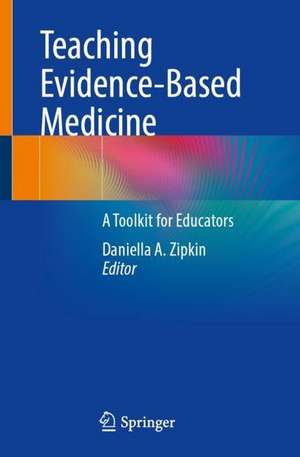Teaching Evidence-Based Medicine: A Toolkit for Educators
Editat de Daniella A. Zipkinen Limba Engleză Paperback – 24 dec 2022
Developed over the past 14 years as an introductory course for interns in the internal medicine residency program at Duke, the curriculum will cover core content areas in evidence-based medicine and best teaching practices for them and skills such as literature searching and applying evidence to patients. Most importantly, it will center on actual patient questions and use current literature as examples that instructors can use as teaching exercises. There will also be ample diagrams that have been shown to be effective with learners and each module will include a video tutorial of a sample teaching session, including visual aids and small group teaching techniques. The curriculum can be implemented in any time frame necessary, compressed or longitudinal, to a variety of learners.
This is an ideal guide for residency program directors and core faculty, either within internal medicine or more broadly in family medicine, pediatrics, surgery, OB-gyn, as well as medical school faculty for use with students.
Preț: 770.10 lei
Preț vechi: 810.63 lei
-5% Nou
Puncte Express: 1155
Preț estimativ în valută:
147.36€ • 154.17$ • 122.41£
147.36€ • 154.17$ • 122.41£
Carte tipărită la comandă
Livrare economică 31 martie-05 aprilie
Preluare comenzi: 021 569.72.76
Specificații
ISBN-13: 9783031111730
ISBN-10: 3031111737
Pagini: 194
Ilustrații: IX, 194 p. 25 illus., 15 illus. in color. With online files/update.
Dimensiuni: 155 x 235 mm
Greutate: 0.39 kg
Ediția:1st ed. 2023
Editura: Springer International Publishing
Colecția Springer
Locul publicării:Cham, Switzerland
ISBN-10: 3031111737
Pagini: 194
Ilustrații: IX, 194 p. 25 illus., 15 illus. in color. With online files/update.
Dimensiuni: 155 x 235 mm
Greutate: 0.39 kg
Ediția:1st ed. 2023
Editura: Springer International Publishing
Colecția Springer
Locul publicării:Cham, Switzerland
Cuprins
1. How To Use This Book.- 2. Clinical Question and Study Design.- 3. Searching the Medical Literature.- 4. Therapy: Assessing the Value of Clinical Interventions.- 5. Non-inferiority Study Designs.- 6. Harm and Causation: Assessing the Value of Studies of Harm.- 7. Diagnostic Testing: Assessing the Value of Studies of Diagnostic Tests.- 8. Screening.- 9. Prognosis.- 10. Systematic Reviews and Meta-Analysis.- 11. Shared Decision Making.
Notă biografică
Daniella A. Zipkin MD is Associate Professor of Medicine and Associate Program Director for Ambulatory Care in the Internal Medicine Residency at the Duke University Health System. She is also a core faculty member of Duke’s national Teaching and Leading Evidence-Based Medicine annual workshop and has won a number of awards for her teaching and clinical work at Duke. She is also a member of the SGIM Education Committee and Career Working Group, as well as former Chair of the Evidence-Based Medicine Task Force.
Textul de pe ultima copertă
Practicing evidence-based medicine is widely regarded both as best clinical practice, and as the cornerstone of meeting the ACGME competencies in Practice-Based Learning and Improvement. Training programs recognize the need to teach the skills of EBM and yet struggle with readily available content and guidance on putting together a curriculum. Time frames for delivering curricula in residency can be very tight, often restricted to scattered one hour conferences. This book provides a modular curriculum structure for instructors, with each topic area taking up one section, or one hour of instructional time. This is an ideal guide for residency program directors and core faculty, either within internal medicine or more broadly in family medicine, pediatrics, surgery, OB-gyn, as well as medical school faculty for use with students.
Developed over the past 14 years as an introductory course for interns in the internal medicine residency program at Duke, the curriculum will cover core content areas in evidence-based medicine and best teaching practices for them and skills such as literature searching and applying evidence to patients. Most importantly, it will center on actual patient questions and use current literature as examples that instructors can use as teaching exercises. There will also be ample diagrams that have been shown to be effective with learners and each module will include a video tutorial of a sample teaching session, including visual aids and small group teaching techniques. The curriculum can be implemented in any time frame necessary, compressed or longitudinal, to a variety of learners.
Caracteristici
Provides a curriculum guide for teaching evidence-based medicine Covers core content areas and key skills in evidence-based medicine Most sections include a video tutorial of a sample teaching session
